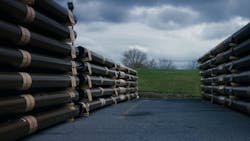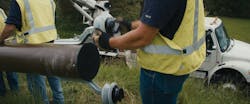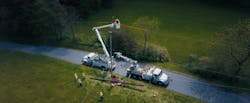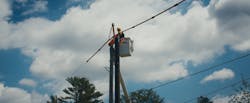Dominion Energy Installs Its First Composite Poles
For engineers at electric utilities, the pressure is on to design a super-resilient power grid that can handle numerous competing demands without tanking the bottom line. It is a tough task.
Broadening the material choice of their poles has helped Dominion Energy to be more sustainable and deliver on its promise of reliable, on-time electric service. The utility has begun integrating composite utility poles into its power grid. Initial installations have already yielded a smoother supply chain, an even safer, more straightforward installation, and the resilience to keep the lights on, no matter what nature has thrown at them.
The Challenge
The top priority for overhead application engineers and other similar roles is ensuring structures will be resilient, reliable and up to code. But the job also involves many other considerations, like total cost, worker safety, supply chain, transportation costs and more. And unlike other industries, the impact of failure is extreme. Utilities must keep the lights on, as they have a responsibility to every person on their system.
Weather and soil conditions in Dominion’s Virginia to North Carolina territory in particular make this challenging. Many areas along the Atlantic Coast are highly salt-contaminated and experience high temperatures and sun exposure. This can desiccate wood poles, weakening them and increasing the likelihood they will wriggle out of the sandy soil during extreme weather, causing lines to fall.
Because of this, and with intense weather events increasing in frequency and load demands rising, Dominion has spent a lot of time in the last few years on grid resiliency. This focus included voluntarily increasing its minimum ANSI Class standards in 2020. For example, a 40-ft (12-m) pole used to require a standard of Class 4. Now, a minimum standard of Class 3 is required for a 40-ft pole. Factoring in the National Electrical Safety Code (NESC) calculations for extreme ice and wind, Dominion found it was installing far more Class 1 poles than in the previous decade.
Supply Chain Issues
However, supply was becoming a problem. The Class 1 wood pole of choice traditionally has been made of southern yellow pine. Because of the limits of Mother Nature and demands for wood from many industries, the number of pole-quality southern yellow pine trees is not where it used to be. Dominion engineers observed they were losing a lot of logging land to other uses, like solar farms. They were finding that most of the trees ready to be cut could not produce a 60-ft (18-m) Class 1 pole — and the ones that could might end up as chips if that were the better seller for the logging company.
The availability problem has required Dominion to broaden its manufacturing plant standards list. The approval process adds substantial work to the plates of employees and includes things like plant visits, environmental standards checks, supply chain and availability checks, and more. Broadened standards also added a new problem: logistics.
This meant considering other materials. The utility found concrete was not the answer, as the strength of these poles comes at the cost of increased weight. With 70% of the world’s internet being powered by Dominion’s systems, the pressure was on to find a pole material that would add reliability and resiliency, especially for high-priority lines, without hiking up costs.
The Solution
Dominion soon realized composite poles met its needs. Assessing available options, Dominion chose poles from Creative Composites Group (CCG). Dominion established its relationship with CCG in 2017 to design crossarms with a special bracket and consistent built-in emergency failure point — to increase the likelihood a pole would survive an extreme weather event.
Composite infrastructural materials range from bridge decking to mooring dolphins to fiber-reinforced polymer (FRP) utility poles. Composites are inherently corrosion resistant, a big draw for wet, salty areas like Dominion’s Virginia to North Carolina territory. An important draw for Dominion was that the CCG poles are made in the U.S., so supply would be available nearly on demand, helping to alleviate wood supply chain woes.
Composite Strengths
FRP also has a very high strength-to-weight ratio, much lighter than conventional materials but with similar strength and stiffness properties. Dominion was used to setting poles with cranes and needing mag or hammer drills. On its first site installing composite poles, engineers and line workers were able to push them upright with one hand because they were light with a predictable balance point. These uniform characteristics have yielded more precise, faster and simpler installation.
The pole break strengths also exhibit a very low coefficient of variation — under 5% — because of the uniformity of the pultrusion process. Compare this to wood’s 20% coefficient of variation, and attendant NESC has strength reduction factors. They also have no taper, like wood, eliminating the need for bolt-length guesswork. In addition, the poles’ dielectric strength increases worker safety, on top of the required personal protective equipment.
Dominion installed its first composite poles in Virginia Beach in spring 2024. Thirty StormStrong poles were installed in a staggered chain, with one composite pole between a certain number of wood poles. Other installations across the U.S. have shown composite poles remain standing through weather events, so the staggered configuration can minimize the impact of an outage from a downed wood pole. These resilient poles also support advancements like self-isolating faults and automated edge computing. In fact, Dominion is now advising composite poles be the priority structure to support devices used in smart grid automation, such as reclosers.
Key Benefits
Although the initial installation has been in place for less than a year, Dominion is already pleased with the results and looks forward to continued performance. Lab testing for ultraviolet resistance and moisture uptake by standards organizations like ASTM indicates composite poles have a 60-year to 100-year service life, depending on their location.
Feedback from Dominion’s line workers has been positive. After getting right to work on installation, the line crews came back and said the composite poles worked great and were a lot simpler to install than concrete or steel. After learning the benefits of composite poles — especially their availability and resiliency — local Dominion project managers quickly backed the project and have since called for its expansion. The poles have also provided another unanticipated benefit: StormStrong poles meet UL 94 with a V0 rating, meaning they will self-extinguish on a vertical burn test. Virginia has seen an increase in wildfires, so mitigation is top of mind for Dominion.
What has perhaps most impressed the team at Dominion is working with the CCG staff. When Dominion employees visited the company’s facility, they met a group that was willing to share information and detailed engineering data. Dominion employees have been able to work directly with the people making the composite poles. In fact, when the Dominion team visited the manufacturer, CCG took a pole off the line and showed Dominion how to drill it. When Dominion asked about flexural strength, CCG took that pole and did a break test.
Looking ahead, Dominion anticipates increasing its composite pole installations to be in the hundreds, as field use proves what lab tests already show about composite poles’ reliability and grid-strengthening properties.
About the Author
Dustin Troutman
Dustin Troutman is corporate director of marketing and product development and sales for the Creative Composites Group (CCG). He earned his BSCE degree in 1993 and spent the early part of his career in utility line construction. Troutman has been with CCG for 27 years and continues to be instrumental in the market investigation and development of major pultrusion products and product lines associated with civil/structural applications, holding four patents related to pultruded systems. He is a key player in the development of codes and standards in support of the FRP industry.
Dean Combs
Norman D. Combs is a professional overhead applications engineer on Dominion Energy’s Distribution Standards team, serving the Virginia to North Carolina territory. He has held different roles at Dominion, including seven years on a line crew and five years on the project design team. His progression through these roles showcases his skill in managing complex projects and his commitment to Dominion’s quality product. He holds two patents, including a wire gauge device.



